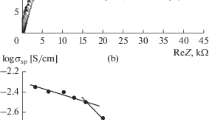Abstract
Nanocomposite organic/inorganic materials made through sol-gel method exhibit high values of ionic conductivity when they were impregnated with the redox couple I −3 /I− Two different kinds of nanocomposite materials, depending on the different interactions between silica and poly(ethylene)oxide or poly(propylene)oxide blends, were prepared by the sol-gel technique in room temperature. Gels, for both nanocomposite materials, were obtained by acetic acid catalyzed solvolysis and were regulated by formation of intermediate products, such as silicon ester and -Si-O-Si-oligomers. Time-resolved fluorescence techniques and conductivity measurements were performed in order to define the parameters which allow maximum probe mobility and minimum confinement conditions with the aim to apply these materials in quasi solid state electrolytes.
Similar content being viewed by others
References
C. Sanchez, F. Ribot and B. Lebeau, J. Mater. Chem.9, 35 (1999).
M.E. Brik, J.J. Titman, J.P. Bayle and P. Judeinstein, J. Polym. Sci.34, 2533 (1996).
T. Keeling-Tucker and J.D. Brennan, Chem. Mater.13, 3331 (2001).
E. Stathatos, P. Lianos, U. Lavrencic Stangar, B. Orel and P. Judeinstein, Langmuir16, 8672 (2000).
B.M. Novak, Adv. Mater.5, 422 (1993).
C. Sanchez, F. Ribot, New J. Chem.18, 1007 (1994).
D. Segal, Chemical Synthesis of Advanced Ceramic Materials, Cambridge University Press (1989).
L. Hench, J.K. West, Chem. Rev.90, 33 (1990).
R.A. Caruso, M. Antonietti, M. Giersig, H.-P. Hentze, J. Jia, Chem. Mater.13, 1114 (2001).
M. Ivanda, S. Music, S. Popovic, M. Gotic, Journal of Molecular Structure645, 480 (1999).
D.P. Birnie, Journal of Materials Science3, 367 (2000).
E.J.A. Pope, J.D. Mackenzie, Journal of Non-Crystalline Solids87, 185 (1986).
E. Stathatos, P. Lianos, U. Lavrencic-Stangar, B. Orel, Adv. Mater.14, 354 (2002).
E. Stathatos, P. Lianos and Ch. Krontiras, J. Phys. Chem. B105, 3486 (2001).
P. Lianos, Heter. Chem. Rev.3, 53 (1996).
P. Levitz, J.M. Drake and J. Klafter, J. Chem. Phys.89, 5224 (1988).
K. Nakashima, Y.S. Liu, P. Zhang, J. Duhamel, J. Feng and M.A. Winnik, Langmuir9, 2825 (1993).
R. Rammal, G. Toulouse, J. Phys. Lettres44, L13 (1983).
S. Alexander, R. Orbach, J. Phys. Lettres43, L625 (1982).
H. Cai, G.C. Farrington, J. Electrochem. Soc.139, 744 (1992).
Author information
Authors and Affiliations
Rights and permissions
About this article
Cite this article
Stathatos, E. Organic-inorganic nanocomposite materials prepared by the sol-gel route as new ionic conductors in quasi solid state electrolytes. Ionics 11, 140–145 (2005). https://doi.org/10.1007/BF02430413
Received:
Accepted:
Issue Date:
DOI: https://doi.org/10.1007/BF02430413




